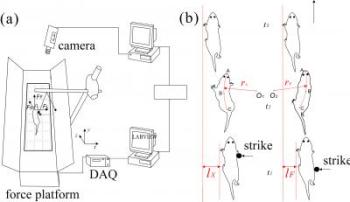Jun 4 2014
The balancing strategy to lateral impact in a rat is closely related to the striked position of the body. The research result can be inspired to improve the robustness of bionic robot. This was found by Dr. JI Aihong and his group from Institute of Bio-inspired Structure and Surface Engineering, Nanjing University of Aeronautics and Astronautics.
This work, entitled "Balancing strategy to lateral impact in a rat Rattus norregicus", was published in Chinese Science Bulletin (In Chinese),2014, Vol 59(13) issue.
 This shows (a) Experimental setup (b) schematic diagrams of rats encountering the lateral thorax strike and the lateral abdomen strike. X- the lateral thorax strike, F- the lateral abdomen strike. Credit: ©Science China Press
This shows (a) Experimental setup (b) schematic diagrams of rats encountering the lateral thorax strike and the lateral abdomen strike. X- the lateral thorax strike, F- the lateral abdomen strike. Credit: ©Science China Press
The center of mass(COM) of animal's body always falls inside the composed polygon of multiple supporting legs during animal locomotion. However, under the interference of environment such as lateral strike and lateral storm, the COM may exceed its security domain. How does animal adjust its movement pattern to balance the outside disturbance? It is necessary to study the animal's balancing strategy to lateral impact to reveal the mechanism of animal keeping stability when locomotion.
In this paper a rat Rattus norregicus was focused to study its balancing strategy to lateral impact. A pendulum was used to strike lateral thorax and lateral abdomen of the animal. Locomotion behavior was recorded by a high speed camera and ground reaction forces were measured by 3-dimensional forces sensors array synchronously during the whole progress of impact and adjustment(Fig 1). The result showed that the balancing strategy to lateral impact in a rat was closely related to the striked position of the body. The rat bent flexible body to absorb the impact energy when encountering the lateral thorax strike, and it resisted the impact force and torque through its side-sway and left leg supporting when encountering the lateral abdomen strike. Animal spent less time on side-sway than on body bending during imergency buffer, but it spent more time on side-sway than on body bending when reverting to original locomotion gait. Balancing strategy to lateral impact in a rat can be inspired to improve the robustness of bionic robot.